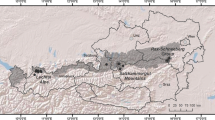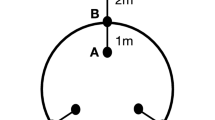Abstract
For the protection or re-establishment of species-rich grasslands, the limiting factors controlling species richness have increasingly become of scientific interest. This study aims to analyze the role of disturbance for the occurrence of a low-competitive herb, Centaurium erythraea Rafn, in mesotrophic, lowland grasslands in NW Germany. We sampled a total of 38 plots with presence of C. erythraea and 24 control (random) plots in semi-natural grasslands. As a proxy for disturbance, we estimated the cover of bare ground and Ellenberg flooding indicator species and measured the distance between the plot and the nearest path. Moreover, we counted the number of C. erythraea individuals within each plot. In the GLM analyses the distance from path was the only predictor; both the presence of the species and the number of individuals decreased with the distance from path. The grasslands at the path edges had the highest disturbance intensity. Here horse riding, military-vehicle traffic and regular sod-cutting directly create bare ground. In general, disturbance creating bare ground seems to be the key factor enabling germination and growth of C. erythraea in mesotrophic grasslands and other low-competitive short-lived species. Disturbance enhances the expression of the seed bank, favours the development of the shade-avoiding and low-growing rosettes and oppresses tall-growing competitors. Therefore we suggest grazing as the best management method.
Similar content being viewed by others
References
Bakker J.P. 1989. Nature management by grazing and cutting. Kluwer Academic Publishers, Dordrecht, 400 pp.
Bobbink R., Hornung M. & Roelofs J.G. 1998. The effect of airborne nitrogen pollutant on species diversity in natural and semi-natural European vegetation. J. Ecol. 86: 717–738.
Brown A.H.F. & Oosterhuis L. 1981. The role of buried seeds in coppice woods. Biol. Conserv. 21: 329–330.
Bullock J.M., Clear H.B., Dale M.P. & Silvertown J. 1994. An experimental study of the effects of sheep grazing on vegetation change in a species-poor grassland and the role of seedling recruitment into gaps. J. Appl. Ecol. 31: 493–507.
Bullock J.M., Franklin J., Stevenson M.J., Silvertown J., Coulson S.J., Gregory S.J. & Tofts R. 2001. A plant trait analysis of responses to grazing in a long-term experiment. J. Appl. Ecol. 38: 253–267.
Chapin F.S., Zavaleta E.S., Eviner V.T., Naylor R.L., Vitousek P.M., Reynolds H.L., Hooper D.U., Lavorel S., Sala O.E., Hobbie S.E., Mack M.C. & Díaz S. 2000. Consequences of changing biodiversity. Nature 405: 234–242.
Chytry M., Hejcman M., Hennekens S. & Schellberg J. 2009. Changes in vegetation types and Ellenberg indicator values after 65 years of fertilizer application in the Rengen Grassland Experiment, Germany. Appl. Veg. Sci. 12: 167–176.
Critchley C.N.R., Burke M.J.W. & Stevens D.P. 2003. Conservation of lowland semi-natural grasslands in the UK: a review of botanical monitoring results from agri-environment schemes. Biol. Conserv. 115: 263–278.
Cousins S.A.O. & Eriksson O. 2008. After the hotspots are gone. Land use history and grassland plant species diversity in a strongly transformed agricultural landscape. Appl. Veg. Sci. 11: 365–374.
Cousins S. 2009. Landscape history and soil properties affect grassland decline and plant species richness in rural landscapes. Biol. Conserv. 142: 2752–2758.
Davies A. & Waite S. 1998. The persistence of calcareous grassland species in the soil seed bank under developing and established scrub. Plant Ecol. 136: 27–39.
Davies A., Dunnett N.P. & Kendle, T. 1999. The importance of transplant size and gap width in the botanical enrichment of species-poor grasslands in Britain. Restor. Ecol. 7(3): 271–280.
Dierschke H. 1994. Pflanzensoziologie. Ulmer, Stuttgart, 683 pp.
Düll R. & Kutzelnigg H. 2005. Taschenlexikon der Pflanzen Deutschlands. Quelle & Meyer, Wiebelsheim, 577 pp.
Dutoit T. & Alard D. 1995. Permanent seed banks in chalk grassland under various management regimes: their role in the restoration of species-rich plant communities. Biodivers. Conserv. 4: 939–950.
Ellenberg H., Weber H.E., Düll R., Wirth V. & Werner W. 2001. Zeigerwerte der Pflanzen von Mitteleuropa. Scripta Geobot. 18: 1–258.
Eriksson O., Cousins S.A.O. & Bruun H.H. 2002. Land-use history and fragmentation of traditionally managed grasslands in Scandinavia. J. Veg. Sci. 13: 743–748.
Fleischer K., Streitberger M. & Fartmann, T. 2010. Zur Ökologie der Wiesen-Glockenblume (Campanula patula) und des Echten Tausendgüldenkrauts (Centaurium erythraea) im Magergrünland Nordwestdeutschlands. Tuexenia 30: 209–229.
Garve E. 2004. Rote Liste und Florenliste der Farn- und Blütenpflanzen in Niedersachsen und Bremen. 5. Fass. Inform.d. Naturschutz Niedersachs. 24: 1–76.
Grime J.P, Hodgson J.G. & Hunt R. 2007. Comparative plant ecology. 2 edn. Castlepoint Press, Dalbeattie, 748 pp.
Hellström K., Huhta A.-P., Rautio P. & Tuomi J. 2009. Seed introduction and gap creation facilitate restoration of meadow species richness. J. Nat. Conserv. 17: 236–244.
Hölzel N. 2005. Seedling recruitment in flood-meadow species: The effects of gaps, litter and vegetation matrix. Appl.Veg. Sci. 8: 115–224.
LANUV — Landesamt für Natur, Umwelt und Verbraucherschutz (ed.) 2012. Rote Liste der gefährdeten Pflanzen, Pilze und Tiere in Nordrhein-Westfalen. Fachbericht 36. Band 1: Pflanzen und Pilze, 536 pp.
Isselstein J., Tallowin J.R.B. & Smith R.E.N. 2002. Factors affecting seed germination and seedling establishment of fenmeadow species. Restor. Ecol. 10: 173–184.
Lavorel S., McIntyre S., Landsberg, J. & Forbes T.D.A. 1997. Plant functional classifications: from general groups to specific groups based on response to disturbance. Trends Ecol. Evol. 12: 474–478.
McIntyre S., Lavorel S. & Tremont R. 1995. Plant life-history attributes: their relationship to disturbance response in herbaceous vegetation. J. Ecol. 83: l–44.
Mierwald U. & Romahn K. 2006. Die Farn- und Blütenpflanzen Schleswig-Holsteins. Rote Liste Band 1. Landesamt für Natur und Umwelt des Landes Schleswig-Holstein, Flintbek, 122 pp.
Münzbergová M. & Herben T. 2005. Seed, dispersal, microsite, habitat and recruitment limitation: identification of terms and concepts in studies of limitation. Oecologia 145: 1–8.
R Development Core Team 2010. R: a language and environment for statistical computing. http://www.R-project.org
Reiné R., Chocarro C. & Fillat F. 2006. Spatial patterns in seed bank and vegetation of semi-natural mountain meadows. Plant Ecol. 186: 151–160.
Ristow M., Herrmann A., Illig H., Klemm G., Kummer V., Kläge H.-C., Machatzi B., Rätzel S., Schwarz R. & Zimmermann F. 2006. Liste und Rote Liste der etablierten Gefäßpflanzen Brandenburgs. Nat.schutz Landsch.pfl. Brandenburg 15(4), suppl.
Rosenbauer A. 1996. Gentianaceae — Enziangewächse, pp. 16–42. In: Sebald O., Seybold S., Philippi G. & Wörz A. (eds), Die Farn- und Blütenpflanzen Baden-Württembergs. Band 5: Spezieller Teil (Spermatophyta, Unterklasse Asteridae) Buddlejaceae bis Caprofoliaeceae. Ulmer, Stuttgart.
Rosenthal G. 2010. Secondary succession in a fallow central European wet grassland. Flora 205: 153–160.
Sala O.E., Chapin F.S., Armesto J.J., Berlow E., Bloomfield J., Dirzo R., Huber-Sanwald E., Huenneke L.F., Jackson R.B., Kinzig B., Leemans R., Lodge D.M., Mooney H.A., Oesterheld M., LeRoy P.N., Sykes M.T., Walker B.H., Walker M. & Wall D.H. 2000. Global biodiversity scenarios for the year 2100. Science 287: 1770–1774.
Standortverwaltung Münster 2005. Schafweideplan. Stand: 19.07. 2005. Unpublished manuscript, Münster. Germany.
Tilman D. 1997. Community invasability, recruitment limitation, and grassland biodiversity. Ecology 78: 81–92.
Trimble S.W. & Mendel A.C. 1995. The cow as a geomorphic agent — a critical review. Geomorphol.13: 233–253
Ubsdell R.A.E. 1979. Studies on variation and evolution in Centaurium erythraea Rafn. and C. littorale (D. Turner) Gilmour in the British Isles. 3. Breeding systems, floral biology and general discussion. Watsonia 12: 225–232.
Van Dijk G. 1991. The status of semi-natural grasslands in Europe, pp. 15–36. In: Goriup P.D., Batten L.A. & Norton J.A. (eds), The conservation of lowland dry grassland birds in Europe. JNCC, Peterborough.
Van Rossum F. 2009a. Succession stage variation in population size in an early-successional herb in a peri-urban forest. Acta Oecol. 35: 261–268.
Van Rossum F. 2009b. Pollen dispersal and genetic variation in an early-succesisonal forest herb in a peri-urban forest. Plant Biology 11: 725–737.
Van Uytvanck J., Milotic T. & Hoffmann M. 2010. Interaction between large herbivore activities, vegetation structure, and flooding affects tree seedling emergence. Plant Ecol. 206: 173–184.
Veen P., Jefferson R., de Smidt J. & Straaten J. (eds.) 2009. Grasslands in Europe of high nature value. KNNV Publishing, Zeist, 320 pp.
Voigtländer U. & Henker H. 2005. Rote Liste der Farn- und Blütenpflanzen Mecklenburg-Vorpommerns. Herausgegeben vom Umweltministerium Schwerin. 5. Fassung, Stand November 2005. Umweltministerium, Schwerin, 61 pp.
Walker K.J., Preston C.D. & Boon C.R. 2009. Fifty years of change in an area of intensive agriculture: plant trait responses to habitat modification and conservation, Bedfordshire, England. Biodivers. Conserv. 18: 3597–3613.
Wilmanns O. 1998. Ökologische Pflanzensoziologie. 6 edn. Quelle & Meyer, Wiesbaden, 479 pp.
Zobel M., Otsus M., Liira J., Moora M. & Möls T. 2000. Is smallscale species richness limited by seed availability or microsite availability? Ecology 81: 3274–3282.
Author information
Authors and Affiliations
Corresponding author
Rights and permissions
About this article
Cite this article
Fleischer, K., Streitberger, M. & Fartmann, T. The importance of disturbance for the conservation of a low-competitive herb in mesotrophic grasslands. Biologia 68, 398–403 (2013). https://doi.org/10.2478/s11756-013-0164-8
Received:
Accepted:
Published:
Issue Date:
DOI: https://doi.org/10.2478/s11756-013-0164-8




